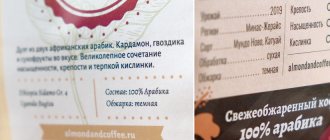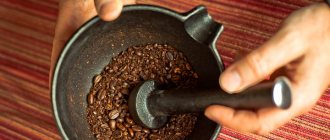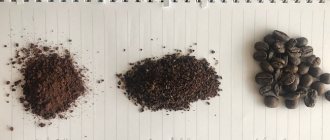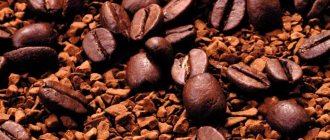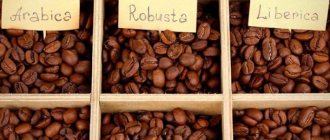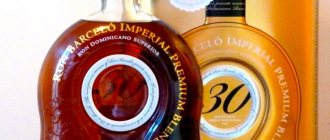Name
Many small producers name their coffees after the farm or village where the coffee is grown. If you see “finca” or “estate” on a pack of coffee, it means the coffee comes directly from a specific location with a very high degree of traceability. Also, the name can be assigned to the next, larger link in the chain. This could be a cooperative that blends, processes and packages coffee from nearby farms and villages. For example Cenfrocafe in Peru. Or the place where the coffee is transported for processing after harvesting - for example, Kigeyo in Rwanda. Less commonly, coffee may be named after the roaster in which it was roasted before packaging.
Roasting coffee beans
Green coffee is aged for some time in special climate-controlled rooms, after which it goes through the sorting stage. At the same stage, the grains are sifted and cleaned of various debris. After which the coffee goes to the roaster.
Coffee roasters, for the most part, are drums into which heat is supplied from the outside. In such drums, coffee beans are roasted, constantly stirring. The fact is that heat is distributed unevenly throughout the coffee bean, which is why even heat distribution and constant movement of the coffee during roasting are important.
At the very beginning of the roasting process, coffee beans first absorb heat and then begin to release it. At this stage, the coffee begins to “shoot”, that is, clicks and crackles of the grain are heard. This stage is called “Up to the first cheek.” Depending on what degree the coffee roaster has planned, there may be more than one change from the endothermic phase to the exothermic phase. That is, coffee can be roasted “until the second click” and beyond.
In heated coffee beans, processes that change its character will continue to occur, even if the heat is removed. To stop the roasting process at exactly the planned phase, the coffee beans are sharply cooled by blowing cold air onto them.
Geographical location / Region
Coffee, like wine, is a territorial drink. In other words, the environmental conditions (temperature, humidity, soil acidity) where coffee is grown affect the taste. As a result, coffee grown in different regions differs in taste. For example, Yirgacheffe in Ethiopia produces a slightly sour, light coffee with powerful floral aromas. Tarrazu in Costa Rica produces sweet coffee with a harmonious, complete taste. Brazilian coffee typically has low acidity and a noticeable nutty aroma.
Price
Natural factory instant coffee costs from 75-80 rubles to 400 rubles per 50 grams. A cheaper product is most likely a mixture with foreign substances.
Ground coffee in instant Nescafe “Gold”, 750 g -25%
745 rub. 993 rub.
Instant coffee Ambassador “Platinum”, 95 g 230 rub.
Instant coffee Ambassador “Platinum”, 190 g 370 rub.
Instant coffee 3 in 1 Nescafe “Classic Cappuccino”, 20 bags 297 rub.
Instant coffee 3 in 1 Jockey “Strong”, 10 bags 86 rub.
Ground coffee in instant Nescafe “Classic”, mixed, 1000 g 935 rub.
Jacobs instant coffee “Monarch”, 47.5 g 132 rub.
Instant coffee Jacobs “Monarch”, 38 g 83 rub.
High-quality instant coffee at TEA.RU
Process
This category is quite important for understanding what kind of coffee you will encounter in a given package. Processing is what happens to coffee between the harvesting of the ripe coffee cherries and the packaging of the dry coffee beans. There are four main ways to process coffee harvest:
- Wet processing / Washed Process (Parchment-Dried)
- Natural Drying / Natural Process (Cherry-Dried)
- Honey Process (Mucilage-Dried)
- Wet-Hulled (Seed-Dried)
Each of these methods has a huge impact on the taste of the coffee. In countries such as Colombia, Guatemala and Kenya, coffee is predominantly processed using the wet method. In this process, the skin of the fruit is removed and the coffee is fermented and washed. This treatment produces a pure coffee taste with greater sweetness and aroma.
Natural drying is common in places without access to much water, such as Yemen and Western Ethiopia, or in places where coffee is grown on a large scale, such as Brazil. Using this method, the coffee is dried with the casing on, resulting in the beans acquiring berry aromas.
Honey processing is a mix of the first two options - coffee beans are husked from the fruit, but the remaining layer of sticky coffee juice (so-called coffee honey) is not washed off, and the beans are dried along with it. This type of coffee is common in Costa Rica, El Salvador, and Panama.
The wet peeling method is mainly practiced in Indonesia.
Where to buy quality instant coffee
While it is considered good practice to buy grain and ground coffee in specialized stores, instant customers most often buy it in supermarkets “at home.” Buying from chain stores is safer, since retailers receive wholesale quantities of goods directly from manufacturers and can guarantee the authenticity of the coffee.
Large online stores also offer coffee from manufacturers. Most often these are direct deliveries or goods from official representatives of the brand.
Variety
Like grapes, apples and almost any other agricultural product, the type of coffee bean has a big impact on the taste. Just as Riesling is different from Chardonnay, Bourbon coffee is very different from Geisha, even if they were grown on the same farm. The main thing is not to confuse the variety and the type (Species) - for example, Arabica is a type of coffee that can contain hundreds of different varieties. And this variety greatly affects the taste of coffee. Sweet and heavy Typica, bright and sour Caturra, or delicate and floral Geisha - the variety of coffee varieties offers a large number of different tastes.
Coffee packaging design
With the help of packaging, the manufacturer communicates with its consumer, so the design should be clear, modern and pleasant. Trends in stylish coffee packaging include laconicism, the use of color images instead of text, and national motifs.
Brand development is a very responsible process and that part of the business that can both ruin it and set it apart from competitors. INTEGRAL+ will help you create a unique design that reveals all the values of your product in style and style.
The coffee industry is an area of activity where neglecting quality packaging can cause irreparable damage and high costs, because the quality of the product directly depends on it. Pay attention to the choice of packaging for coffee.
Growing Height/Elevation
Very few coffee consumers are interested in the altitude at which the coffee was grown. For the American market, this information is generally of little use, because most manufacturers indicate the altitude in meters (try saying right away - how much is 4000 feet above sea level?) But for coffee professionals, it is important to know the altitude. As a rule, the higher the plantation is located, the higher the quality of the coffee, and so on as long as the plant is able to survive. Coffee trees grown at altitude have a higher concentration of sugars and acids, resulting in a sweeter, more complex aroma in the cup. Low-rising coffees tend to have lower acidity, so if you're trying to avoid sourness in your coffee, knowing the altitude can be helpful.
How to understand coffee varieties
Let's start with the most banal question: what are Arabica and Robusta? The topic is hackneyed, but important, without it there is no point in talking about types of coffee.
The first and main thing is like two and two: Arabica and Robusta are not varieties! These are different TYPES of trees, of which there are quite a few, but only a few are used for food. Arabica and Robusta are the most common. Coffee varieties are different hybrids of one of the species, obtained naturally or artificially.
Schematically it looks like this:
We won’t focus on the details, we’ll just offer a simple experiment.
Do a mini-research
To understand the fundamental difference in taste and the popularity of Arabica, take pure espresso, without sugar and milk, from any coffee machine (on the street, at the entrance to a shopping center). Smell it, try it. Do you smell earthy and bitter? In 90% of cases it is robusta. To consolidate the result, try on the same day to go to a good coffee shop where Arabica beans are brewed and repeat the experiment. Check it out - the difference is colossal!
Let's assume that we have figured out the types of coffee, and with a pure soul we can move on to varieties.
Coffee varieties
We will talk about Arabica varieties. We won’t get involved with robusta for now, and you probably already understand why: there are very few varieties suitable for consumption in its pure form, and you still need to look for them.
The first thing you will see on a pack of Arabica beans is the name of the country. Due to inexperience, many people think that this indicates the place of production. Let's dot the i's. We are talking about the country where the coffee tree grows. If you see the inscription: "Salvador Pacamara", know that the beans were harvested in El Salvador. The place of roasting and packaging is most likely completely different - look for it at the bottom or back of the pack, where technical information is indicated.
Is it good or bad? Answer: no way. It all depends on the skills of the roaster and the integrity of the manufacturer.
So, the first and mandatory information is the place of growth: Mexico Maragogyp, India Monsund Malabar, Brazil Santos, etc.
Further, different data are indicated, depending on the labeling system adopted in each individual country. Let's look at the most common options.
Region
Most often, the name of the state is followed by a region (region, locality). This variety labeling is accepted in countries where coffee is grown throughout the territory. Grains collected in different parts of the country can vary greatly in taste due to different altitudes above sea level, soil characteristics, etc.
Example : Costa Rica Tarrazu , Ethiopia Sidamo/Jimma/Yirgachef .
Tree type
The next labeling option is a tree variety that has been naturally mutated or artificially bred. Most often you can find Typica beans in a pack. This name is not printed on the packaging as a matter of course. Indicated if the grain was collected from a tree of a different type.
Example : Mexico Maragogyp , Salvador Pacamara , Brazil Yellow Bourbon .
The diagram shows the origin of the most common Arabica varieties.
Some producers may provide information not only about the country and region of origin, but even the name of the farm from which the crop was harvested.
This is followed by various “technical” data: grain hardness, its size, height of growth, method of processing and selection.
Grain size
The way grain sizes are marked may vary from country to country. The most accurate option is to indicate the “screen” - the size of the holes in the sieve that is used for calibration. Screen 16, 17, 18 and 19 – coarse grain.
For Indonesian coffee, the letters used are L (large), M (medium), S (small).
In Haiti - X - small grain, 3X - medium, 5X - large.
In some African countries, the following labeling is adopted: AAA - large, AA - medium, AB - small.
In Colombia - Supremo - large grain, Excelso - small.
It should be noted that large grains are not always an indicator of quality. Undoubtedly, there is a difference in taste, but the correlation between large grains and high quality is not correct. Ask why the price is so different? The answer lies in the level of production specifics, which we will not delve into now.
Growing height
But the altitude at which coffee is grown greatly affects the taste. High altitudes, firstly, add acidity to the grain. Secondly, due to slow ripening, the berries have time to be saturated with a huge amount of essential substances, which makes the drink very rich and aromatic.
High-altitude Arabica varieties are usually labeled as SHG (Strictly High Grown). This means that the plantation from which the coffee is harvested is located at an altitude of 1500-2000 m above sea level. They are followed by HG (High Grown) - 1000-1500 m.
Grain hardness
Hardness usually correlates with height—the higher, the denser the grain. SHB – (Strictly Hard Bean) – more than 1400 m. HB (Hard Bean) – slightly lower, 1200-1400 m.
Processing method
Everything is quite simple here. Washed is a wet processing method, unwashed/natural/dry is a dry method. What is the difference? Washed Arabica varieties have a fairly clean and light taste, with hints of fruit, berries and flowers. Dry processing makes the drink heavier, adding deep chocolate notes and sweetness.
The third option appeared not so long ago. It is something in between and is called semi-moist, pulped or semi-washed. The labeling of such varieties is semi-washed, pulped-natural, or less commonly, honey processed.
Among all the coffee countries, India stands out. Here, washed coffee is designated as Plantation, dry-processed as Cherry.
Indonesia abbreviates the designation to WP (wet-processed), DP (dry-processed).
Grain selection system
Finally we reached the far “corner” of grain labeling. Here we will decipher the mysterious abbreviations EP and AP, which are not so often seen on a pack.
EP (European Preparation) is a European grain selection system. This preparation allows for the presence of no more than 8 defective beans per 300 g. The result is coffee of the highest quality with a minimum number of defects that affect the taste.
AP (American Preparation) is an American system that allows you to leave up to 23 defective grains per 300 g.
Additional designations
Peaberry/pearl – whole, round grains. Sometimes, instead of two grains, a coffee berry develops one, but large one.
Grade (1,2) – grain quality. Marking of specialty coffee, indicating the number of defects in the batch. Grade 1 – highest quality.
Monsooned Malabar is a special way of processing Indian coffee, in which the grain is “aged” in the open air during the monsoon season.
Organic – coffee is grown without the use of chemical fertilizers.
General scheme
To summarize, decoding the name of the Arabica variety occurs according to the following scheme: locality (country, region, farm) - technical data (variety, grain hardness, height, selection, processing).
Agree, now it’s a little easier to navigate among the huge variety of coffee varieties. And the name Costa-Rica Tarrazu SHB EP is no longer puzzling, right? Try deciphering it, it's easy.
Sedina Evgenia
It’s clear how to distinguish a fake from an original, but what next?
Our actions:
We turned to Rospotrebnadzor with our question and for appropriate clarification.
In response to our first request, we received an “unsubscribe”, which, to put it mildly, did not suit us.
Therefore, we submitted a new application for reconsideration and are now waiting for a serious investigation on their part regarding the suspicious coffee.
In general, it took us several letters to different departments of Rospotrebnadzor for our appeal to be noticed and accepted for work. Such an irresponsible attitude on the part of the regulatory authorities in the presence of obvious and gross violations came as a great surprise to us and caused some bewilderment.
Our actions did not stop there; we also sent letters to the French representative offices of the brand - on Facebook, Instagram, and the official email. But, unfortunately, our requests went unheeded and we never received an answer.
Anna contacted the store manager, where she discovered the questionable coffee. She was unable to obtain clear information on the questions she was interested in.
As we later found out, counterfeit coffee products are sold not only in small shops, but also on large marketplaces - Ozon, Beru, and have various forms of packaging that do not match the original.
Having requested a declaration of conformity in one of the stores distributing these coffee products, we discovered that it was issued to a certain company PROVENCE LLC. And most importantly, the manufacturer is Russia, although it is clearly written on the packaging that it is made in France! The information obtained from the official document fully proves that the company IS NOT a French distributor, but IS a Russian manufacturer!
We were unable to find the official website of the company. There is no information on the packaging. Apart from the declaration of conformity, the company does not have any data - no website, no social networks, no address, no phone number, no other contacts or details. Which also seemed very strange to us for an “official distributor”.
Degrees of roasting of coffee beans
There is no unified system for classifying degrees of roasting. Each country may use its own gradations and names for them. You may come across numbering: from 1 to 5. Or names: Cinnamon roast, Viennese, Italian...
The numbers indicate coffee from the lightest roast to the darkest, when the beans acquire a dark brown, tending to black, shade of color. And usually there are five such gradations. Here, it seems, everything is clear. Let's try to correlate them with their names.
Cinnamon roast
Cinnamon (very light, light or even pale) roasting is a process where coffee beans are roasted “to the first click”. The grains become light brown and have a “dry”, that is, matte surface.
This coffee has high acidity and a refined taste. It produces tart, “herbaceous” flavors in the cup and is virtually devoid of sweetness. This roast is also known as the “New England” roast. Usually inexpensive coffee is roasted to this degree, intended for later preparation in a Turkish coffee pot and brewing in a cup.
American roast
American (light) roast coffee is beans roasted to a light brown color, but the color is not yet uniform, the coffee beans remain “variegated.” The surface of the grains is “dry”. Roasting is stopped at the “first click”.
The acidity of such grains is lower, the sweetness is more pronounced and is especially noticeable in the aroma. This roasting can highlight the characteristic features of some varieties. Light roast coffee is suitable for preparation in a Turk, French press or drip method. Many inexpensive “everyday” brands of coffee are roasted this way.
City roast
City roasting (or medium roasting) is a process in which coffee beans become brown in color, and their surface becomes slightly “oily” and acquires a barely noticeable gloss. Coffee acquires the same familiar “coffee aroma”, while it is possible to preserve the natural taste of coffee beans.
This coffee can be prepared in traditional ways: in a Turk or French press, or can be used to make espresso in a coffee machine. The taste of the drink becomes noticeable sweetness with a “caramel” hint of burnt sugar.
Full City Roast
The beans are roasted until the “second click” begins (dark roast), their color tends towards dark brown, the surface becomes more glossy. The sweetness begins to decrease and chocolate notes appear in the aroma. The taste itself becomes more intense, but already distinctly “roasted” with a slight coffee bitterness.
Coffee of this roast is used to prepare espresso in coffee machines.
Viennese roast
During Vienna roasting, coffee beans acquire a dark brown color, their surface becomes increasingly “oily” and glossy. During this roasting process, the coffee beans begin to smoke a little.
There is practically no acidity in this coffee, although the sweetness is still noticeable. Espresso is prepared from Viennese roasted coffee; the drink has a bright, rich aroma, but there are practically no natural shades left in the taste. The taste begins to fill with a characteristic “coffee bitterness”.
French roast
It is often called “The Heart of the Dark Roast.” This is probably the most popular type of roast for espresso. The beans become shiny, the coffee itself is a rich dark brown color. The grains are fried until the end of the “second click”. The taste of the drink is rich and thick, but it is already the taste of well-roasted grain. There is no longer that sophistication that is inherent in light roasted coffee beans.
Italian roast
Beans roasted to the Italian roast level become almost black and brittle. There is nothing left of the natural taste of coffee here. The taste is bitter, the aroma of coffee exudes quite strong. This type of roasting often disguises low-quality coffee beans.
Spanish roast
This roast is also known as “Neapolitan” or “Dark French roast”. The color of coffee beans can already be called black, their surface is glossy, “greasy”. The aroma of this coffee is more reminiscent of charcoal. The taste, however, is about the same. This kind of coffee is very much for everyone.
That's probably all that concerns the degrees of roasting of coffee beans. This information will help you navigate choosing coffee beans to suit your taste when you decide to buy coffee online or in a regular store. The flavors are described rather conventionally, but you can certainly understand the general direction of their development depending on the degree of roasting. However, one more important question remains.
Sublimated (“freeze-dried”)
Sublimation (from the Latin sublimatio - “elevation, ascension”) is the newest and most expensive method of producing instant coffee, allowing to preserve all the original properties of natural coffee to the maximum. The technology is as follows: a very strong coffee infusion is frozen to a temperature of -40C, the ice turns into steam - evaporates - bypassing the liquid phase. And the coffee remains in the form of crystals. The vacuum dehydrates the coffee crystals and gives freeze-dried coffee a more subtle taste and aroma than other types of instant coffee.
Instant coffee was invented in 1908 by Japanese-American inventor Satori Kato, who adapted his instant tea technology for coffee. He did this by order of a certain American company. Later, it was the Americans who spread instant coffee around the world, and during World War II, instant coffee was part of the diet of American troops. In 1909, instant coffee appeared on the wider market under the name “RED-E-COFFEE”, thanks to the invention of the Englishman George Constant Washington, who lived in Guatemala. One day, while waiting for his wife in a cafe, he noticed coffee dust on a silver spoon - condensation of coffee vapor. And soon he invented the technology for its intentional preparation. Modern instant coffee was invented in 1938 in Brazil. The country found it necessary to preserve surplus coffee beans. The problem was solved by the Swiss chemist Max Morgenthaler. It is he who is called the father of the invigorating instant drink. If you believe the statistics, most of humanity today consumes instant coffee.
- When purchasing a can of instant coffee, you should consider its labeling.
- If the label is red or there is a red spot on the packaging, this coffee is considered strong and is recommended for morning consumption.
- A green or blue label (as well as a corresponding spot on the packaging) indicates less strength. This type of coffee can also be consumed during the day or evening.
- If the packaging does not indicate the composition of the product, it is assumed that the product consists of 100% natural coffee.
(1 like)
ABS plastic
Previous post
Prepagato
Next entry
Content
- 1 Wikipedia
- 2 Small academic dictionary
- 3 Consumer vocabulary
- 4 Advantages and disadvantages of instant coffee 4.1 Advantages of instant coffee:
- 4.2 Disadvantages of instant coffee
- 5.1 Powdered (powdered) coffee
Instant coffee
is a drink made from roasted coffee beans. Using various technological processes, coffee is dehydrated and turned into powder or granules. After adding hot water, you get a drink that tastes close to natural coffee. In some brands of instant coffee, in addition to dehydration itself, decaffeination is also carried out - reducing the caffeine content.
soluble
-aya, -oe; -ri?m, -a, -o. Soluble. Soluble salts. Instant coffee.
Instant coffee
– a coffee drink made from natural coffee and does not require traditional preparation methods. When producing instant coffee, they try to preserve the taste, aroma and tonic properties of natural coffee. Its main advantage is the simplicity and speed of preparation, as well as a longer shelf life compared to ground coffee or coffee beans.
The inventor of instant coffee is the Japanese scientist Satori Kato. He developed the basic principle for making this drink in 1901. The principle of industrial production of instant coffee was developed by the English chemist D. C. Washington in 1906. And already in 1909, the first commercial batch of instant coffee, Red E Coffee, entered the market.
The first truly popular brand of instant coffee was Nescafe coffee from Nestle. After World War II, this product gained wide popularity, first in the United States and then throughout the world.
Is GOST required for coffee?
GOSTs are standards that are recommended for voluntary use. In some cases, the mandatory nature of GOSTs is dictated by laws. For example, construction or transport regulations.
For coffee, GOST is voluntary, at least for now. There is already a discussion about the mandatory introduction of GOSTs, but this is clearly a matter for the future.
If the manufacturer puts a mark on the label indicating that its coffee complies with GOST, and you find out that this is not the case, then the manufacturer will be held liable under the law.
GOST is a voluntary certification, but if the manufacturer recognizes it, then he must comply with its requirements, otherwise legally approved consequences will occur.
